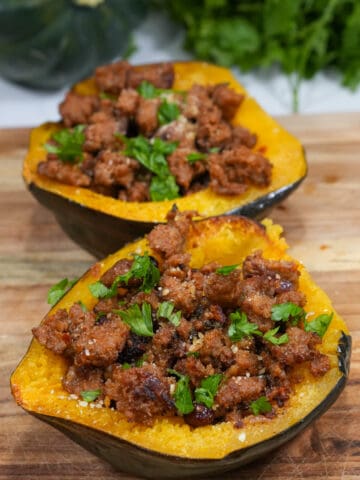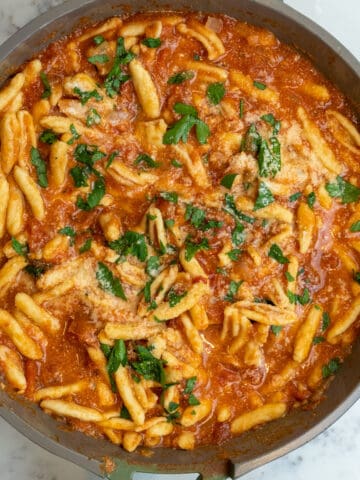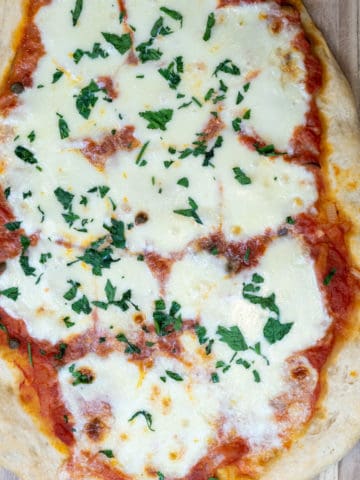This Pepperoni Pizza Recipe with Marinara Sauce is made with pizza dough, marinara sauce, mozzarella, pepperoni, and cherry tomatoes.

This will forever be my favorite pizza dough to make from scratch. It is SO easy, you won’t believe you made it. Not to mention pepperoni pizza is my absolute favorite pizza.
If you love this recipe, feel free to check out my Pizza Margherita and my Pizza Puttanesca.
Jump to:
- How to make homemade pizza dough?
- What type of outdoor Pizza Oven to use?
- Can I cook homemade pizza in my oven?
- Why you will love this recipe
- Pepperoni Pizza Recipe Ingredients
- How to make Pepperoni Pizza
- Can Pizza Dough be made ahead of time?
- What Should I Serve Pepperoni Pizza With?
- Substitutions
- Pepperoni Pizza Recipe Variations
- Equipment
- How to store Pepperoni Pizza
- Pepperoni Pizza Recipe Top tips
- Food safety
- Pepperoni Pizza Recipe
How to make homemade pizza dough?
Making homemade pizza dough is a fun and rewarding process that allows you to customize the flavors and textures of your pizza to your liking. Here's a simple recipe for making pizza dough at home:
Ingredients:
- 2 cups all-purpose flour
- 1 teaspoon active dry yeast
- 1 teaspoon salt
- 1 teaspoon sugar
- ¾ cup warm water
- 2 tablespoon olive oil
Instructions:
- In a large mixing bowl, combine the flour, yeast, salt, and sugar. Mix well.
- Add the warm water and olive oil to the dry ingredients. Stir with a wooden spoon until a shaggy dough forms.
- Turn the dough out onto a floured surface and knead for about 5 minutes, until the dough becomes smooth and elastic. You can add a little more flour if the dough feels too sticky, or a little more water if it feels too dry.
- Shape the dough into a ball and place it back into the mixing bowl. Cover the bowl with a clean towel or plastic wrap and let the dough rise for about 1 hour, or until it has doubled in size.

What type of outdoor Pizza Oven to use?
- Wood-fired pizza oven: Wood-fired ovens are traditional and offer a unique smoky flavor to pizzas. They are typically made of brick or stone and require wood as a fuel source. They can reach high temperatures quickly, allowing for fast cooking times and crispy crusts. Wood-fired ovens require some skill to operate and maintain, but they are a popular choice for authentic pizza enthusiasts.
- Gas-fired pizza oven: Gas-fired ovens are convenient and easy to use, as they are powered by propane or natural gas. They heat up quickly and offer precise temperature control, making them ideal for those who want a more user-friendly option. Gas-fired ovens are typically made of stainless steel and can be portable or built-in, depending on your needs.
- Electric pizza oven: Electric ovens are convenient and easy to use, as they only require an electrical outlet for power. They are typically smaller and more portable, making them suitable for smaller spaces or for those who want a more portable option. Electric ovens may not reach the high temperatures of wood-fired or gas-fired ovens, but they can still produce delicious pizzas.
Can I cook homemade pizza in my oven?
Yes, you can absolutely cook homemade pizza in your oven! Homemade pizza is a delicious and fun meal to make at home, and many people use their ovens to bake pizzas with great success. Cooking homemade pizza in your oven is a popular method for making delicious pizza at home. With the right ingredients and techniques, you can achieve a crispy crust, melty cheese, and flavorful toppings.
Why you will love this recipe
Versatile: Get creative if your toppings. You can add burrata, banana peppers, oregano, or even a balsamic glaze.
Full of flavor: The marinara sauce, mozzarella, and basil pack such a delicious combination of flavors.
Kid Friendly: What kid doesn't like pizza? Pizza days were always my favorite in my house.
Great for all weather: I enjoy this pizza in the winter and summer months.
Pepperoni Pizza Recipe Ingredients
You'll only need a few simple ingredients to make this. The exact measurements are listed in the recipe card below. Here's an overview of what you'll need:
- Pizza dough
- Marinara sauce
- Fresh Mozzarella
- Pepperoni
- Cherry Tomatoes
- Basil
See recipe card for quantities.
How to make Pepperoni Pizza
Preheat the oven to 450 F. When the dough is ready, cut in half and cling wrap one half to keep for another time. Add flour on the counter and flatten the other dough out with a roller. Make sure to put flour on your hands and on the roller to keep the dough from sticking! Spray a baking sheet with non stick spray. Add the pizza on it.

With a spoon, add the marinara on the pizza.

Slice the mozzarella and add about 5 slices or more if needed. Cut the cherry tomatoes in half and add as well.

Finally add the pepperoni. Put in the oven for about 15 minutes.

After the pizza is done, add about 6 pieces of basil on it. The heat of the pizza will soften the basil leaves. Feel free to drizzle on olive oil and salt on it as well.
Hint: Feel free to broil for 1-2 minutes extra if you want it to be more brown.
Can Pizza Dough be made ahead of time?
Yes, pizza dough can be made ahead of time and stored for later use. In fact, many pizza dough recipes benefit from a longer resting period as it allows the dough to develop flavor and texture. Making pizza dough ahead of time can also save you time and effort when it comes to making pizzas for a meal or an event. You can refrigerate for 72 hours or freeze the dough for up to three months.
What Should I Serve Pepperoni Pizza With?
- Salad: A fresh salad can be a great side dish to balance out the richness of the pizza. You can make a simple garden salad with mixed greens, tomatoes, cucumbers, and a vinaigrette dressing. Alternatively, you can try a Caesar salad with crisp romaine lettuce, Caesar dressing, croutons, and Parmesan cheese.
- Garlic knots or breadsticks: Soft, garlicky knots or breadsticks can be a delicious accompaniment to pepperoni pizza. You can make them from scratch or purchase them from a store. They're great for dipping in marinara sauce or enjoying on their own.
- Vegetable side dish: Adding some vegetables to your meal can provide a balance of flavors and nutrients. You can roast some vegetables, such as bell peppers, mushrooms, or zucchini, with olive oil, salt, and pepper for a flavorful side dish. Alternatively, you can sauté or steam some vegetables and season them with herbs or a sprinkle of Parmesan cheese.
- Pasta or grain-based side dish: A pasta or grain-based side dish can complement the pizza and make it a more substantial meal. You can serve spaghetti, fettuccine, or penne tossed in marinara sauce or with garlic and olive oil. Alternatively, you can prepare a side of risotto, quinoa, or couscous with vegetables and herbs.
Substitutions
Pizza dough: You can make your own pizza dough or just buy store bought pizza dough.
Marinara Sauce: My favorite brand of marinara sauce is Rao's, but feel free to use any bran you prefer.
Mozzarella: I used fresh mozzarella and not shredded mozzarella. The fresh mozzarella melts really well. You could use either one.
Basil: Feel free to use oregano or parsley.

Pepperoni Pizza Recipe Variations
- Spicy Pepperoni Pizza: If you like some heat, add a kick to your pepperoni pizza by using spicy pepperoni or adding sliced jalapenos or crushed red pepper flakes on top. The extra heat will add a spicy and tangy flavor to the pizza.
- Margherita Pepperoni Pizza: Combine the flavors of a Margherita pizza with pepperoni by using fresh tomatoes, basil, and mozzarella cheese along with the pepperoni slices. Drizzle with olive oil and sprinkle with salt and pepper for a simple and classic twist on pepperoni pizza.
- Hawaiian Pepperoni Pizza: Add a sweet and salty twist to your pepperoni pizza by adding pineapple and ham. The sweetness of the pineapple complements the salty flavor of the pepperoni and ham, creating a unique and delicious combination.
- White Pizza with Pepperoni: Skip the tomato sauce altogether and make a white pizza with pepperoni. Use a garlic and herb-infused olive oil or Alfredo sauce as the base, and top with mozzarella cheese, ricotta cheese, sliced tomatoes, and pepperoni for a creamy and flavorful twist on traditional pepperoni pizza.
- BBQ Bacon Pepperoni Pizza: Combine the smoky flavors of BBQ sauce and bacon with pepperoni for a delicious twist. Use BBQ sauce as the base, and top with cooked and crumbled bacon, red onion slices, mozzarella cheese, and pepperoni. Bake until crispy and bubbly for a unique and tasty pizza.
Check out my Neapolitan Pizza Recipe.
Equipment
- Oven: A conventional oven or a pizza oven is needed to bake the pizza to perfection.
- Pizza Stone or Pizza Steel (optional): A pizza stone or steel can help create a crispy crust by evenly distributing heat to the dough. It's placed in the oven and preheated before placing the pizza on top.
- Pizza Peel (optional): A pizza peel is a large, flat wooden or metal paddle used to transfer the pizza to and from the oven. It can be helpful for sliding the pizza onto the pizza stone or steel in the oven.
- Mixing Bowls: Bowls for mixing and kneading the pizza dough.
- Measuring Cups and Spoons: To accurately measure the ingredients for the dough and pizza sauce.
- Rolling Pin: To roll out the pizza dough to the desired thickness.
- Cutting Board and Knife: To slice the pepperoni, cheese, and other toppings.
- Baking Sheet or Pizza Pan: A baking sheet or pizza pan can be used to shape and bake the pizza if you don't have a pizza stone or steel.
- Whisk or Spoon: To mix and combine the pizza sauce ingredients.
- Spatula or Pizza Cutter: To slice and serve the cooked pizza.

How to store Pepperoni Pizza
- Refrigeration: If you have leftover pepperoni pizza that you want to store in the short term, you can keep it in the refrigerator. Place the pizza slices in an airtight container or wrap them tightly in plastic wrap or aluminum foil. Store in the refrigerator for up to 3-4 days.
- Freezing: If you want to store pepperoni pizza for a longer period, you can freeze it. Wrap the pizza slices tightly in plastic wrap or aluminum foil, or place them in airtight containers or freezer-safe bags. Label and date the containers or bags. Store in the freezer for up to 1-2 months for best quality.
- Individual Wrapping: Alternatively, you can individually wrap each pizza slice with plastic wrap or aluminum foil before storing them in the refrigerator or freezer. This can help prevent them from sticking together and make it easier to thaw and reheat individual slices as needed.
- Avoid stacking: When storing pepperoni pizza slices in the refrigerator or freezer, it's best to avoid stacking them on top of each other to prevent them from sticking together or becoming squished.
- Reheating: When you're ready to enjoy your stored pepperoni pizza, you can reheat it in the oven, toaster oven, or microwave. For best results, reheat in the oven or toaster oven for a crispy crust. To prevent the pizza from becoming soggy, place it directly on the oven rack or on a preheated pizza stone or steel if you have one.
Pepperoni Pizza Recipe Top tips
- Use High-Quality Ingredients: The quality of your ingredients will greatly impact the taste and overall quality of your pizza. Choose fresh and high-quality ingredients, including the pizza dough, pizza sauce, cheese, and pepperoni, for the best results.
- Preheat Your Oven and Pizza Stone/Steel: Preheat your oven and pizza stone or steel (if using) for at least 30 minutes at the highest temperature possible (usually around 500°F/260°C or higher). A hot oven and preheated pizza stone/steel will help create a crispy crust.
- Stretch and Shape the Dough Properly: When stretching or rolling out the pizza dough, be gentle and avoid overworking it. Allow the dough to rest for a few minutes before shaping it into your desired pizza shape. Avoid using too much flour, as it can dry out the dough and affect the texture of the crust.
- Use Thinly Sliced Pepperoni: For a classic pepperoni pizza, use thinly sliced pepperoni that will crisp up nicely in the oven and release its flavorful oils. You can also arrange the pepperoni slices in a single layer to prevent them from becoming too greasy.
- Don't Overload with Toppings: Avoid overloading your pizza with too many toppings, as this can make the pizza soggy and difficult to bake evenly. Keep it simple and balance the amount of sauce, cheese, and toppings for a well-balanced pizza.
- Brush the Crust with Olive Oil: Brushing the crust with a little olive oil before baking can add extra flavor and help create a crispy crust.
- Bake on a Hot Surface: If using a pizza stone or steel, transfer the pizza onto the preheated surface using a pizza peel. This will help create a crispy bottom crust. If using a baking sheet or pizza pan, preheat it in the oven to get it hot before placing the pizza on it.
- Keep an Eye on the Pizza While Baking: Pizza cooks quickly, so keep a close eye on it while baking to prevent burning. The cooking time may vary depending on your oven and the thickness of the crust, so use visual cues to determine when it's done.
- Let the Pizza Rest Before Slicing: Allow the pizza to rest for a few minutes after baking before slicing it. This will help the cheese set and make it easier to slice without the toppings sliding off.
- Customize to Your Taste: Feel free to customize your pepperoni pizza recipe to your personal taste preferences. You can experiment with different types of cheese, add other toppings like onions, bell peppers, or mushrooms, and adjust the amount of sauce and seasoning to suit your liking.
Food safety
- Cook to a minimum temperature of 165 °F (74 °C)
- Do not use the same utensils on cooked food, that previously touched raw meat
- Wash hands after touching raw meat
- Don't leave food sitting out at room temperature for extended periods
- Never leave cooking food unattended
- Use oils with high smoking point to avoid harmful compounds
- Always have good ventilation when using a gas stove
See more guidelines at USDA.gov.
Print
Pepperoni Pizza Recipe
- Total Time: 30 minutes
- Yield: 4 servings 1x
Description
This Pepperoni Pizza Recipe with Marinara Sauce is made with homemade dough, marinara sauce, mozzarella, pepperoni, and cherry tomatoes.
Ingredients
- 15 oz store bought pizza dough (or make your own- see notes*)
- 5 tablespoons of marinara sauce or store bought
- 1 fresh mozzarella
- 15-20 pepperoni slices
- 1 cup of chopped cherry tomatoes
- 6 basil leaves
- Salt, as needed
Instructions
- Preheat the oven to 450 F. Add flour on the counter and flatten the other dough out with a roller. Make sure to put flour on your hands and on the roller to keep the dough from sticking! Spray a baking sheet with non stick spray or use parchment paper. Add the flattened dough onto the baking sheet.
- With a spoon, add the marinara on the pizza and spread it. Slice the mozzarella and add about 5 slices or more if needed. Cut the cherry tomatoes in half and add, cut side down, as well. Finally add the pepperoni. Put in the oven for about 15-20 minutes. Feel free to broil for 1-2 minutes extra if you want it to be more crispy.
- After the pizza is done, add about 6 pieces of basil on it. The heat of the pizza will soften the basil leaves. Feel free to drizzle on olive oil and salt on it as well.
Notes
- Use High-Quality Ingredients: The quality of your ingredients will greatly impact the taste and overall quality of your pizza. Choose fresh and high-quality ingredients, including the pizza dough, pizza sauce, cheese, and pepperoni, for the best results.
- Preheat Your Oven and Pizza Stone/Steel: Preheat your oven and pizza stone or steel (if using) for at least 30 minutes at the highest temperature possible (usually around 500°F/260°C or higher). A hot oven and preheated pizza stone/steel will help create a crispy crust.
- Stretch and Shape the Dough Properly: When stretching or rolling out the pizza dough, be gentle and avoid overworking it. Allow the dough to rest for a few minutes before shaping it into your desired pizza shape. Avoid using too much flour, as it can dry out the dough and affect the texture of the crust.
- Use Thinly Sliced Pepperoni: For a classic pepperoni pizza, use thinly sliced pepperoni that will crisp up nicely in the oven and release its flavorful oils. You can also arrange the pepperoni slices in a single layer to prevent them from becoming too greasy.
- Don't Overload with Toppings: Avoid overloading your pizza with too many toppings, as this can make the pizza soggy and difficult to bake evenly. Keep it simple and balance the amount of sauce, cheese, and toppings for a well-balanced pizza.
- Brush the Crust with Olive Oil: Brushing the crust with a little olive oil before baking can add extra flavor and help create a crispy crust.
- Bake on a Hot Surface: If using a pizza stone or steel, transfer the pizza onto the preheated surface using a pizza peel. This will help create a crispy bottom crust. If using a baking sheet or pizza pan, preheat it in the oven to get it hot before placing the pizza on it.
- Keep an Eye on the Pizza While Baking: Pizza cooks quickly, so keep a close eye on it while baking to prevent burning. The cooking time may vary depending on your oven and the thickness of the crust, so use visual cues to determine when it's done.
- Let the Pizza Rest Before Slicing: Allow the pizza to rest for a few minutes after baking before slicing it. This will help the cheese set and make it easier to slice without the toppings sliding off.
- Customize to Your Taste: Feel free to customize your pepperoni pizza recipe to your personal taste preferences. You can experiment with different types of cheese, add other toppings like onions, bell peppers, or mushrooms, and adjust the amount of sauce and seasoning to suit your liking.
- Prep Time: 10 minutes
- Cook Time: 20 minutes
- Category: Lunch
- Method: Baking
- Cuisine: Italian
Nutrition
- Serving Size: 1
- Calories: 305.0
- Sugar: 7.5 g
- Sodium: 1,468.2 mg
- Fat: 7.4 g
- Saturated Fat: 0.5 g
- Carbohydrates: 38.9 g
- Fiber: 2.4 g
- Protein: 19.7 g
- Cholesterol: 12.1 mg








Gloria
This pizza was everything I ever dreamed of. I love bursted cherry tomatoes!